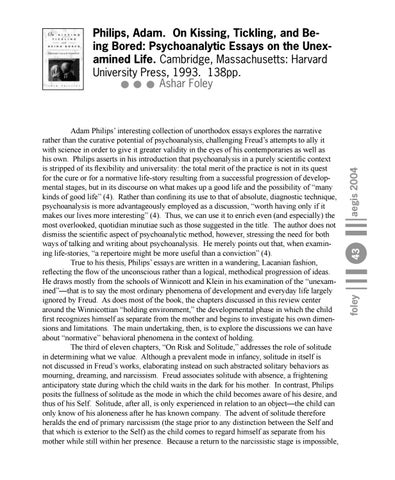43 foley
Adam Philips’ interesting collection of unorthodox essays explores the narrative rather than the curative potential of psychoanalysis, challenging Freud’s attempts to ally it with science in order to give it greater validity in the eyes of his contemporaries as well as his own. Philips asserts in his introduction that psychoanalysis in a purely scientific context is stripped of its flexibility and universality: the total merit of the practice is not in its quest for the cure or for a normative life-story resulting from a successful progression of developmental stages, but in its discourse on what makes up a good life and the possibility of “many kinds of good life” (4). Rather than confining its use to that of absolute, diagnostic technique, psychoanalysis is more advantageously employed as a discussion, “worth having only if it makes our lives more interesting” (4). Thus, we can use it to enrich even (and especially) the most overlooked, quotidian minutiae such as those suggested in the title. The author does not dismiss the scientific aspect of psychoanalytic method, however, stressing the need for both ways of talking and writing about psychoanalysis. He merely points out that, when examining life-stories, “a repertoire might be more useful than a conviction” (4). True to his thesis, Philips’ essays are written in a wandering, Lacanian fashion, reflecting the flow of the unconscious rather than a logical, methodical progression of ideas. He draws mostly from the schools of Winnicott and Klein in his examination of the “unexamined”—that is to say the most ordinary phenomena of development and everyday life largely ignored by Freud. As does most of the book, the chapters discussed in this review center around the Winnicottian “holding environment,” the developmental phase in which the child first recognizes himself as separate from the mother and begins to investigate his own dimensions and limitations. The main undertaking, then, is to explore the discussions we can have about “normative” behavioral phenomena in the context of holding. The third of eleven chapters, “On Risk and Solitude,” addresses the role of solitude in determining what we value. Although a prevalent mode in infancy, solitude in itself is not discussed in Freud’s works, elaborating instead on such abstracted solitary behaviors as mourning, dreaming, and narcissism. Freud associates solitude with absence, a frightening anticipatory state during which the child waits in the dark for his mother. In contrast, Philips posits the fullness of solitude as the mode in which the child becomes aware of his desire, and thus of his Self. Solitude, after all, is only experienced in relation to an object—the child can only know of his aloneness after he has known company. The advent of solitude therefore heralds the end of primary narcissism (the stage prior to any distinction between the Self and that which is exterior to the Self) as the child comes to regard himself as separate from his mother while still within her presence. Because a return to the narcissistic stage is impossible,
aegis 2004
Philips, Adam. On Kissing, Tickling, and Being Bored: Psychoanalytic Essays on the Unexamined Life. Cambridge, Massachusetts: Harvard University Press, 1993. 138pp. Ashar Foley

